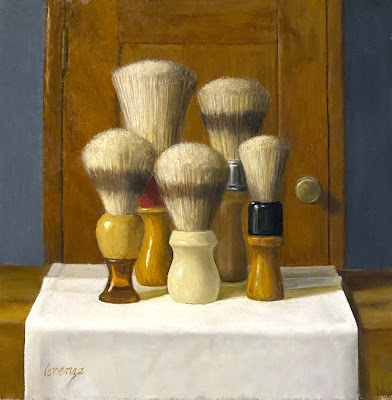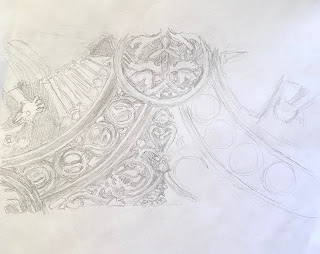Composing a painting is hard. I'm usually inspired by an actual object, but inspiration can also come from the desire to capture a particular texture, finish or light effect. And as happened here, even the simplest subject (plums) can become complicated.
This latest painting started in the produce aisle where red-purple plums were looking rather regal. In my studio, while figuring out how to highlight their glory, they sat in a spatterware pie plate. Not exactly regal, but spatter grey against glossy purple made a nice contrast. So that was the start of what was meant to be a horizontal painting starring purple plums.
And then this happened.
 |
| Plum Regal ©2020 Dorothy Lorenze |
A simple portrait of produce became a regal throne of intricate tapestry. Well, maybe just plums on a tea towel, but certainly elevated by the rich pattern. Really, the complimentary colors of green-blue and red-purple were just perfect. So... what to do about that fabric pattern?!
A detailed drawing is almost always my starting point. For this painting I focused on the plums and the ellipse of the pie tin. Figuring I'd do a looser impression of the fabric pattern, and kind of wing it to avoid being too mechanical.
Realism is challenging, of course, and involves training your eye to see the small details that will add to the interest of the painting. It can also mean training your brain to ignore some degree of detail to maintain the poetry. So I gave myself permission to be not entirely literal with the fabric while still creating a level of realism that felt right, to me. That meant drawing the fabric to provide key shapes and elements of the pattern to be a road map for painting the pattern.
More detail than just winging it and less than photo accuracy. In the end it did not feel like a compromise, but a successful rendering of my vision. And that's a great feeling.
I drew, but, also used photos to check my work. There are artists who work strictly from photos and those who believe that's cheating. My feeling is photos can be a tool, not the same as personal observation - which is OK when you know how photos can flatten images and effect color. I don't want to be so literal that I miss the personality of the subject. Artists have different backgrounds and different goals, and that's fine. As Karen O'Neil used to say, "There's no right or wrong. There's only what works and what doesn't".
I drew the plums and the pie tin as accurately as possible, focusing on the ellipse of the tin and positions of the plums front/back, above/below one another. Then transferred the drawing to the painting surface. You can see an example of this process here.
Things were going along ok but the pie tin wasn't quite right. So I took a photo of the painting, marked the center axis of the tin and folded it to see if it was symmetrical. The left side looked more accurate to me so I cut through the folded pieces which slightly reshaped the right side to match the left. The depth of the tin had been off slightly causing the angle to be sharper and that made the difference. You can see this on the right side of the cut printout - very hard to visually measure!
 |
| checking symmetry |
Checking symmetry this way helps separate what your brain knows from what your eyes see. When drawing a symmetrical object on paper you simply fold it in half, use backlight to see if the sides align. You can't do that with canvas, hence the photo. (This can also be accomplished with a tracing, but the painting was wet.)
At this point the fabric was looking more sloppy than impressionist. So I made a greyscale image of the painting to help determine how stark or subtle the contrast was in the fabric pattern. I could see that not only were the thread colors closer in value but there were variations throughout where the light hit differently. This helped to make the fabric more natural and realistic.
 |
| comparing values with a greyscale image |
I was still at the ugly duckling stage of this painting - a time when its easy to get frustrated or lose confidence. But on this day my audio book was ... a bit different. It was the story of David Goggins, Navy Seal, USAF Tactical Air Control and ultra athlete. Don't laugh, but I was inspired.
Goggins came from an abusive background where he always felt like a loser. After many personal disappointments, he challenged himself, stopped making excuses, worked hard and never settled. It's a raw story and I can't exactly recommend the totality of it. However, I will say, it's hard not to do your very best when his voice is in your ear!
Thank you for joining me on my art journey and please share these posts with those you feel might enjoy them. If this post was shared by a friend, if you like, sign up on my website to receive monthly newsletters from my art studio.













